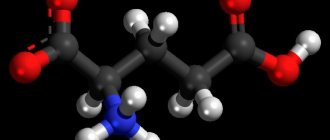Magnesium - what is its role in the human body
- Promotes proper development of bone tissue.
- Helps eliminate spasms in the muscles of vital organs, including reducing the likelihood of a heart attack, as it can relieve destructive tension in the heart muscle.
- A preventive measure against inflammation of the mucous membranes.
- Dilates blood vessels.
- Has a beneficial effect on the beauty and health of the skin.
- Improves absorption in the intestine, and also improves its motility.
- Helps regulate metabolic processes
- Prevention of diabetes.
- Stimulates the secretion of bile.
- Helps remove excess cholesterol.
- Supports the body's immune system.
- Positively affects the health of the heart and blood vessels.
- Makes teeth enamel stronger.
- Prevents the deposition of kidney stones.
- Reduces pain due to PMS.
And one more fun fact: magnesium has become famous for helping people suffering from hangovers.
The body's need for magnesium is normal
The main source of magnesium for humans is everyday food. Of course, the daily norm is a very conditional concept, since the need for magnesium is influenced by age, gender, and the general physical condition of the body.
It is generally accepted that the norm is from 300 to 500 mg.
The need increases in the presence of intense physical or intellectual stress.
For children, the norms are significantly different.
The optimal calculation for children under 10 years of age is 6 to 1. That is, 6 mg of macronutrients per 1 kilogram of weight.
Why do we need magnesium?
Even at the beginning of the twentieth century, doctors would never have thought to associate irritability, frequent mood swings, night leg cramps and rapid heartbeat with a lack of some minerals in the body. The food was healthy and balanced. In the 50s, with the development of the food industry, doctors started talking about magnesium deficiency, and in 1995 the WHO officially recognized it as a pathological condition.
In a complex chemical laboratory - the human body - the role of magnesium can hardly be overestimated:
| Organs, systems and processes | Functions of the mineral |
| Immunity | Participates in the formation of antibodies |
| Heart and blood vessels |
|
| Nervous system | Coordinates the work of nervous and muscle tissue, reducing excitability (eliminates convulsive readiness). |
| Metabolism |
|
| Skeletal system |
|
| Hormonal system | Participates in the production of the hormone estrogen and testosterone |
And that’s not all, we haven’t looked deep into this laboratory yet. During pregnancy, normal levels of this mineral become especially important. It is necessary for both the woman and the fetus.
Symptoms of magnesium deficiency are observed in most of the urban population. How can you help yourself not only preserve, but also promptly replenish reserves of this much-needed mineral? It is best to get it from food. What foods contain the most magnesium?
Magnesium deficiency - main causes
Most often, magnesium deficiency is caused by insufficient magnesium in the daily diet.
In addition, there is a magnesium deficiency due to genetics, but this is the rarest case. Also one of the problems is modern methods of food processing.
In agriculture, chemicals are often used to treat plants, and magnesium will be lost if the product is kept in water for a long time.
The problem may also lie in a number of other reasons.
- Problems with excess weight.
- Renal dysfunction.
- Abuse of fatty foods, sweets and excess salt in food.
- Use of diuretics.
- Unbalanced nutrition, strict diets.
- Pregnancy.
- Excessive consumption of coffee and strong tea.
- Stress.
- Alcohol consumption.
- Diarrhea.
- Problems with the absorption of the element due to excess lipids, phosphates and calcium.
- Problems with insulin production.
- Heavy metal poisoning.
- Impaired absorption functions of the intestine associated with diseases.
Products containing magnesium in an easily digestible form
The first steps in the bioavailability of magnesium are mechanical chewing of food and exposure to stomach acid. After splitting, the mineral is well absorbed in the small intestine. There it passes from the “villi” to the capillaries, which are located in the small intestine. It is then absorbed in small quantities in the large intestine. Thus, complete absorption of the microelement in the body occurs:
- 40% of consumed magnesium is absorbed in the small intestine;
- 5% is absorbed in the colon;
- 55% remains in the body as waste.
Depending on the type of magnesium consumed and the person's health, these values may be higher or lower. Total micronutrient absorption is below 20% in some people. "Magnesium absorption" is a term used to refer to the entry of magnesium into the blood through mechanisms in the small intestine. Foods that may promote optimal mineral absorption:
- Fructose and complex carbohydrates;
- Protein, excluding unfermented soy products;
- Medium chain triglycerides such as: coconut oil and palm oil;
- Fermentable or soluble fibers, such as those from fruits and vegetables.
More interesting things
What foods contain a lot of protein: tables and descriptions
Foods that inhibit magnesium absorption:
- Insoluble fibers such as whole grains, bran and seeds;
- Foods high in phytates, such as whole grains and flours, bran, unsprouted beans and soybeans;
- Foods high in oxalates such as spinach, leafy greens, nuts, tea, coffee and cocoa. The listed products are characterized by a high magnesium content, but it is better to consume them separately.
Foods that contain high concentrations of fiber, phytic acid and oxalic acid help absorb magnesium. It is better to choose grains whose fibers contain a large amount of this substance. Grain fibers with low mineral content, as well as fresh bread and white flour, have less of it, which will hinder full absorption.
Symptoms of excess magnesium in the body
Excessive amounts of magnesium are harmful to the body. The two main reasons are both overuse and metabolic problems.
Do not forget that magnesium is a macronutrient, long-term consumption of which, especially in combination with calcium and phosphorus, can provoke poisoning.
The scientific name for excess magnesium is hypermagnesemia.
Hypermagnesemia may occur if:
- use anticides containing magnesium;
- taking laxatives if you have kidney problems;
- in case of renal dysfunction.
In turn, excess magnesium in the body provokes a number of disastrous consequences, including:
- psoriasis;
- dyslexia;
- diseases of the thyroid gland;
— deposition of calcium salts;
- arthritis.
Taking medications
We looked at magnesium in detail, what foods contain it, the table above gives you an idea of this. But what to do if the symptoms of deficiency are obvious and it is not possible to cope with them only by changes in the menu?
There are such forms of Mg:
- Magnesium citrate - has an average absorption rate, but gives a good sedative effect.
- Malate is suitable for athletes because it relieves soreness after training.
- Threonate is relevant for increased mental stress and cognitive impairment (indicated for students, retirees, and Alzheimer's patients).
- Oxide - only 5% is absorbed, which is quite enough for a laxative effect.
- Glycinate has good bioavailability, is indicated for increased anxiety, panic attacks, and has no laxative effects.
- Magnesium oil is convenient for use in the form of a solution; it can also be used to massage the head and temporal area for migraines. As a bonus there will be stimulation of hair growth.
- Mineral water containing magnesium. This drink not only saturates the body with the necessary element, but also stimulates the activity of liver cells to produce bile.
The benefits of magnesium for the human body
How is this mineral useful for the body?
- It is involved in protein synthesis.
- Normalizes the functioning of the nervous system and heart muscle.
- Has a vasodilating effect.
- Activates bile secretion.
- Facilitates the condition of women with menopausal disorders.
- Improves intestinal motility.
- Helps eliminate cholesterol.
- Fights inflammatory processes.
- Improves oxygen supply to tissues.
- It affects more than 300 enzymes that are involved in the formation of energy.
- Eliminates stress, anxiety, increased nervous excitability, restlessness.
For a person to feel good and be healthy, a balance of elements is necessary. Experts believe that magnesium and calcium should be in a 2:1 ratio. Often there is a clear deficiency of magnesium, so it is necessary to restore its deficiency.
Magnesium Rich Foods
Products containing magnesium: among cereals, preference should be given to bran, rice, buckwheat. Soybeans, beans, and lentils are also rich in magnesium. There is a lot of it in nuts, dairy products, and greens. A real storehouse of magnesium is cocoa beans.
| Products | Magnesium content, mg per 100 g of product |
| Nuts: | |
| Cashew | 270 |
| Almonds, pine nuts | 235 |
| Pistachios | 200 |
| Peanut | 180 |
| Hazelnut | 170 |
| Walnut | 120 |
| Seeds: | |
| Pumpkins, poppy | 530 |
| Sunflower | 420 |
| sesame | 350 |
| Legumes: | |
| Lentils | 380 |
| Soya beans | 250 |
| Beans | 130 |
| Peas | 100 |
| Cereals: | |
| Wheat bran | 590 |
| Wheat germ | 320 |
| Buckwheat | 260 |
| Full grain rice | 160 |
| Barley grits | 160 |
| Oat groats | 140 |
| Wheat groats | 130 |
| Semolina | 70 |
| Dairy products: | |
| Cow's milk whey powder | 180 |
| Soft cheeses | 30-50 |
| Hard cheeses | 50-100 |
| Milk | 12-15 |
| Vegetables | |
| Corn | 43 |
| Brussels sprouts, beets | 40 |
| Potato | 30 |
| Greenery | |
| Sorrel | 85 |
| Cilantro | 80 |
| Dill | 40 |
| Fruits: | |
| Dates | 70 |
| Persimmon | 60 |
| Bananas, avocados | 40 |
| Dried fruits | 70-100 |
| Cocoa | 400 |
| Sea kale | 170 |
| Egg | 50 |
When food is cooked and soaked in water, magnesium is lost from it, so everything that can be eaten without heat treatment is best eaten raw. But even from fresh magnesium products, about 35-40% of the quantitative values given in the table are absorbed.
Article on the topic: What foods contain calcium.
How to determine magnesium deficiency
To identify magnesium deficiency in the body, it is necessary to understand the causes of its deficiency and the basic symptoms. Considering the high need for this element in the nervous system, gastrointestinal tract, muscle tissue and endocrine glands, it is not difficult to assume that the shortage may be caused by an uneven ratio of costs and receipts of the substance.
Thus, any repeated physical activity, prolonged nerve tension and stress cause an increased need for vitamins and microelements in the body. Naturally, magnesium is one of them. Therefore, knowing this, you can prevent unwanted consequences in the bud. To do this, you need to adhere to a proper varied diet and take vitamin complexes during increased loads.
This is especially important for athletes, because magnesium is responsible for the absorption of calcium, that is, without it, the risk of fractures, tears of ligaments and muscles increases.
Micronutrient deficiencies also often follow kidney and stomach diseases. Magnesium is also washed out by alcoholic drinks and coffee. When taking medications with a diuretic effect, antibiotics or contraceptives, you should definitely consult a doctor about the accompanying diet.
The symptoms of elemental deficiency can be quite similar to other ailments, so self-diagnosis is not recommended for anyone. If you detect any signs of health problems, you must contact the clinic to get a correct diagnosis. The most common symptoms:
- fast fatiguability;
- persistent mild headache or dizziness;
- problems with memory and concentration;
- depressive states, depression and causeless anxiety;
- poor appetite;
- dry hair and nails;
- unhealthy skin appearance.









